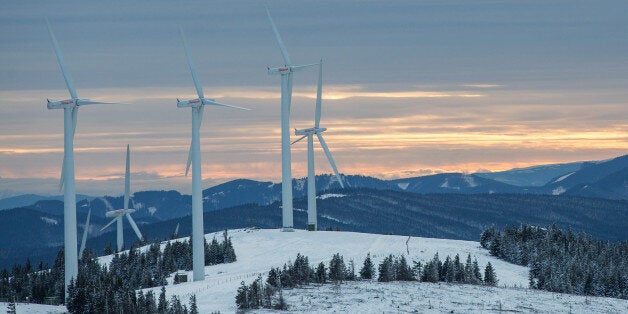
Heading into the New Year, global financial markets are experiencing yet another bout of volatility and turbulence. Many political, economic and environmental uncertainties and threats cloud the year ahead.
One thing is clear, however. From a strategic perspective, 2015 built a new set of policy foundations for the global economy, signaling new directions for the financial system. We now have the Global Goals for Sustainable Development, the so-called SDGs, which, in essence, plot out an annual investment pipeline measured in the trillions to end poverty and also marry increased prosperity with social inclusion and environmental regeneration. And we also have the Paris Agreement on Climate Change, which signaled the shift to a low and ultimately net zero carbon economy, stressed the urgency of improving resilience to climate shocks and mobilized financial institutions and regulators in novel ways.
So, if 2015 designed the foundations, the task for the financial community in 2016 is to take the practical steps to deliver the reallocation in capital that's required, and doing this in ways that result in an orderly transition in global markets. For
Achim Steiner, Executive Director of the United Nations Environment, "2016 is set to be the year of green finance. Across the world, we are seeing a growing number of countries aligning their financial systems with the sustainability imperative."
One of these is the UK -- and some of the key aspects of this year's green finance agenda were highlighted at the Mansion House in the heart of the City of London, where UK financial leaders gathered in early January. The buzz was clear -- a mix of appreciation of a new generation of risks around climate change and dwindling global resources as well as a sense of major opportunities still to be harvested. In the words of the Lord Mayor of the City of London, Jeffrey Mountevans, this is "not a cuddly extra or nice to have." And by looking back 10 years to the mid-2000s, it's possible to appreciate just how far markets have already moved and start to map out the road that lies ahead.
The financial crisis of 2007-8 marks a decisive break, of course, one which has actually helped to accelerate the momentum behind green and sustainable finance across five key dimensions: new leadership, institutions, markets, signals and ambitions.
New Leadership: Back in 2005, green or sustainable finance was mostly the preserve of specialists departments and institutions in the industrialised world. Now there is mainstream commitment -- witnessed by the US59 trillion in assets under management supporting the Principles for Responsible Investment, who's 10 year anniversary takes places this year. But the geographic centre of gravity has also shifted. China has emerged as a global champion of green finance -- making it part of its societal mission to build an 'eco-civilisation.' According to Ma Jun, chief economist of the People's Bank of China, international cooperation is critical to construct common rules and build capacity; green finance will be a key theme of its presidency of the G20 in 2016 through a new study group co-chaired with the UK.
New Actors: Sustainability is also increasingly seen as part of the mandate of the guardians of the financial system, the world's central banks and regulators. Ten years ago, green finance was a simply a question of consumer preference. Now in a world of more fragile and constrained economic growth, it's impacting overall system performance. The Bank of England has been at the forefront of this shift, publishing the world's first prudential review of the climate implications for the insurance sector and galvanising the establishment of the Financial Stability Board's task force on climate disclosure. Andrew Bailey, Deputy Governor of the Bank of England explained how increasing awareness of climate change is providing "the natural bridge to green finance" with the task of policy not to apply heavy regulatory pressure but to facilitate the rerouting of private finance.
New Markets: Back in 2006, the embryonic carbon market was seen as the main pivot for green finance. It's still viewed as critical, but no longer plays the central role. Instead, attention is focusing on shifting core asset classes, not least the US100 trillion in the global bond market. Green bonds didn't exist a decade ago -- and have grown rapidly in recent years to some US42 billion in issuance in 2015. This remains a drop in the big bond ocean -- and for Spencer Lake, Global Head of Capital Financing at HSBC the task is to "industrialise" the global green bond market through common reporting, credit enhancement and new risk protection tools.
New Signals: Financial markets are often skeptical of government policy pronouncements. But for Elizabeth Corley, CEO of Allianz GI, "the Paris Agreement moved the option of green finance from the periphery to the core of the future of world capital markets." Crucial to the next phase will be crafting the right package of policy and market signals including consistent disclosure, better analytics (for example of stranded asset risks), clear definitions to avoid 'greenwashing,' as well as clarity on questions of arbitration and potential litigation. Underpinning all of this is urgent need to the build up of sustainability expertise among professionals and policymakers to close the gaps in understanding that still exist.
New Ambitions: Green finance is quickly moving from a niche agenda to one that shapes national ambitions for financial sector development. In the UK, a new Green Finance Initiative was launched by the City of London, supported by both the Treasury and the Department of Energy and Climate Change, with the aim of promoting London "as a leading global centre for green financial services." A new report from UNEP has identified the UK as a hub for many of the innovations across the green finance agenda -- but also one which had seen early leadership in the past slip to other markets. For Harriet Baldwin, Economic Secretary to the Treasury, the task for the UK was "to pull out all the stops." This ambition is not unique to the UK. India's securities regulator has just laid out its roadmap for growing its domestic green bond market.
Looking ahead another 10 years, even larger shifts are in the offing. The UK has announced, for example, that it will be phasing out coal-fired power generation by 2025. Ultimately, the endgame lies in the democratization of green finance, so that individual savers and investors as well as corporations have the financial tools at their disposal to shift the trillions towards sustainability.
